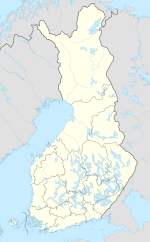| This article includes a list of references, related reading, or external links, but its sources remain unclear because it lacks inline citations. Please help improve this article by introducing more precise citations. (May 2020) (Learn how and when to remove this message) |
| Kyminlinna | |
|---|---|
| Part of South-Eastern Finland fortification system | |
| Finland | |
 Kyminlinna main gate Kyminlinna main gate | |
 | |
| Coordinates | 60°30′26″N 26°53′19″E / 60.50722°N 26.88861°E / 60.50722; 26.88861 |
| Type | Caponier fortress |
| Area | 74 hectares (180 acres) |
| Site information | |
| Owner | Senate Properties |
| Open to the public | no |
| Condition | Partly in disrepair |
| Site history | |
| Built | 1803 (1803) |
| Built by | Russian Empire |
| In use | 1808 (1808) |
| Materials | Earth, masonry |
Kyminlinna (literally, 'the castle of Kymi') is a fortress located in the northern part of island of Hovinsaari in Kotka, on the south coast of Finland. Kyminlinna is part of the South-Eastern Finland fortification system built by Russia after the Russo-Swedish War of 1788-1790. Kyminlinna formed the northern part of a double fortification, together with Ruotsinsalmi sea fortress, where Kyminlinna was intended to repulse land-based attacks along the King's Road.
Physical description
Kyminlinna is a five-corner-caponier approximately 800 metres (870 yd) in diameter. The surface area of the fortress is approximately 74 hectares (180 acres).
The fortress is surrounded by incomplete moats, which also form part of the ditch system intended to drain the grounds. There is a pond in the area despite the draining intentions.
The eastern part of the ramparts are dissected by the Kotka railway built in 1890, and the Kymintie road built in the early 20th century. The national road 7 goes through the outer ramparts of the southern part of the fortress.
The fortress houses 23 buildings, most of which have been empty after Finnish Defence Forces ceased using the fortress, and which are in varying states of disrepair.
History
The first fortification in the Kyminlinna location was a bastion fortress of a few hundred metres in diameter, built between 1791 and 1795. The construction of the fortress was initially supervised by the Russian Marshall Alexander Suvorov, later followed by the Dutch-born General Jan Pieter van Suchtelen. This so-called 'Suvorov fortress' was demolished to make room for the new, six times larger Kyminlinna, which was built in 1803–1808.
General Suchtelen designed the new fortress and supervised its construction. The fortress was not quite ready by the time Finnish War began, and lost its intended military usefulness after the border between Russia and Sweden moved from Kymi River to Torne River. Kyminlinna did not see action during the Crimean War, when the Ruotsinsalmi sea fortress was destroyed.
During the Finnish Civil War Kyminlinna was used by Red Guards as a training centre. Kyminlinna fortress saw its only battle during the civil war on April 9, 1918, when a German unit attacked the red guards based in the fortress. The battle resulted in few casualties, among them the German soldier Willy Heinz, who is buried in the Kotka old cemetery.
During World War II Kyminlinna was used as refugee camp for Ingrian Finns. The fortress was also used as a prisoner of war camp, tuberculosis hospital and civil guard firing range.
Kyminlinna was used by Finnish Defence Forces between 1939 and 2005.
The area is currently owned by the Finnish government real estate enterprise Senate Properties.
Gallery
-
 The main gate on the south-western side of the fortress
The main gate on the south-western side of the fortress
-
Gate detail
-
A partially collapsed tunnel
-
 Guardhouse and the north-eastern gate of the fortress
Guardhouse and the north-eastern gate of the fortress
Sources
- Finnish national board of antiques Kyminlinna research
- http://www.ymparisto.fi
- http://kulttuuriymparisto.nba.fi
External links
| Finnish castles, fortresses and fortifications | |||||
|---|---|---|---|---|---|
| Middle Ages |
| ||||
| 18th and 19th-century fortifications | |||||
| 20th-century fortresses | |||||
| Castles, fortresses and fortifications located outside modern-day Finnish borders shown in italics. | |||||